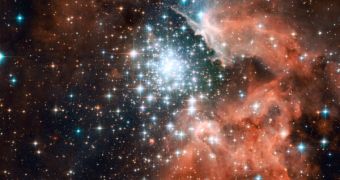A group of astronomers was puzzled to discover a number of brown dwarfs while conducting a survey of a star cluster located relatively nearby in astronomical terms. The discovery is peculiar because we shouldn't theoretically be able to see objects such as these at such distances.
The team's suspicions were first aroused when looking at data from the Hubble Space Telescope. The observations revealed the existence of nine stars in the cluster that did not exactly belong there.
One of the things that first stood out about them was that they were really cool, and significantly colder than any regular star. On the other hand, they did have surface temperatures ranging between 1,700 and 2,000 degrees Kelvin.
This is indicative of the fact that the objects are most likely brown dwarfs than regular stars. Dwarfs of this type are in essence failed stars, that did not ignite properly when they were first born.
According to astrophysicists, this can happen when the molecular clouds from which stars develop do not gather enough mass before imploding. As such, when it comes time for the gas agglomerations to ignite, they fail to trigger nuclear fusion.
The resulting object is called a brown dwarf, which is basically a very cool star, or a very large gas giant. The debate about how these objects should be interpreted is still from over in the international astronomical community.
Hubble discovered the nine objects in the open star cluster NGC 3603, using infrared wavelengths. The detectors on the observatory were sensitive enough to pick up the existence of the brown dwarfs even if they were concealed among much brighter stars.
“We were quite puzzled” at the new discovery, explains Loredana Spezzi, who holds an appointment at an European Space Agency (ESA) center in Noordwijk, the Netherlands. She and her team believe that these brown dwarfs first generated planetary systems around them, but then consumed them whole.
In a paper published in the latest issue of the esteemed Astrophysical Journal, the investigators propose an explanation for why these stars are so dim and cool, while at the same time remaining detectable from such huge distances.
They say that the objects may in fact be actual stars. They may have consumed exoplanets in their orbits some time ago, by ripping them apart, and then swallowing their debris. However, some of these debris may still cover up the stellar surfaces, reducing their brightness and temperatures.
This would certainly explain why the stars remain visible from 20,000 light-years away, and would clear the mystery as to why they are warmer than regular brown dwarfs at the same time, New Scientist reports.

 14 DAY TRIAL //
14 DAY TRIAL //